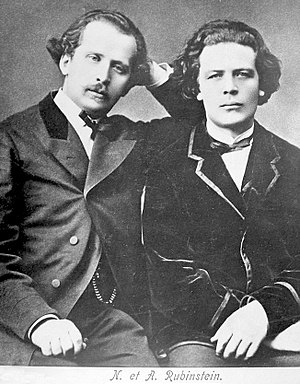Symphonies by Anton Rubinstein. Playlist
 |
| Portrait bust of Anton Rubinstein on his grave in Tikhvin Cemetery, Saint Petersburg (Photo credit: Wikipedia) |
5. Anton Rubinstein Symphony No. 2 "The Ocean" (1851)
the original 4 movement version of the work.
Conducted by Igor Golovchin with the Russian State Symphony Orchestra.
I. Allegro Maestoso - 00:00
II. Adagio Non Tanto - 15:58
III. Allegro - 26:50
IV. Allegro - 33:01
6-11. Anton Rubinstein - Symphony No 3 Op 56
12. Anton Rubinstein Symphony No. 4 "Dramatic" (1874)
Conducted by Robert Stankovsky with the Czecho-Slovak State Philharmonic Orchestra.
I. Lento - Allegro Moderato - 00:00
II. Presto - 23:15
III. Adagio - 39:11
IV. Largo - Allegro Con Fuoco - 48:26
Rubinstein wrote his fourth symphony in 1874, the year of his eleventh opera, Die Makkabäer. He conducted a performance at the Crystal Palace in London during the course of a visit to England in 1877, when he also introduced to the English public his Ocean Symphony, pejoratively described by Mussorgsky as "a puddle". The first three movements of the Dramatic Symphony are scored, with all the clarity of Mendelssohn, for the normal classical orchestra, with pairs of flutes, oboes, clarinets, bassoons, trumpets, French horns and timpani and strings. The symphony opens with a slow and ominous introduction, a violin motif entering above the sinister motif entrusted to cello and double bass. A dramatic Allegro moderato, where both motifs are used gives way to a more lyrical theme and a third of heroic triumph. The movement is in the prescribed classical form, with a central development that introduces some new material, before the return of the original themes, the first of which ends the movement.
The second movement Scherzo, again in D minor, includes passages of delightful interplay between pairs of wind instruments. There is a contrasting section with a solo violin, over an ostinato bass and a Trio in D major, before the return of the opening Scherzo. The F major Adagio opens with the strings playing a long-drawn melody. The woodwind at first predominate in a second theme, over a running violin accompaniment. Divided cellos and double bass introduce a flute solo and the woodwind return to the first theme before the end of the movement. Drama erupts again in the final movement, which opens with a slow introduction, to which trombones and piccolo are now added, before the unison strings embark on the Allegro con fuoco, with its angular opening theme. A second theme, in F major and marked Moderato assai, is ushered in by the first violins. There is a contrapuntal interlude for woodwind, based on an accompanying figure first heard in the opening bars of the symphony and an extended passage derived from the principal theme, before the return of the forceful theme itself. The second theme now returns in A major, played by the French horn. The symphony ends in heroic D major triumph.
 |
| Rubinstein Nikolai & Anton (pianist & composer) (Photo credit: Wikipedia) |
Conducted by Gilbert Varga with the Philharmonia Hungarica.
I. Moderato Con Moto - 00:00
II. Moderato Assai - 11:49
III. Allegro Vivace - 19:29
IV. Moderato Assai - 28:47
As a composer, Rubinstein enjoyed success with some of his operas, particularly The Demon, based on the poem by Lermontov, while his symphonies, works of classical clarity, proved impressive enough. The first symphony was written in 1850, with the second, the famous Ocean Symphony, composed in the following year and later revised and augmented. The last of his six symphonies was written in 1866.
Symphony No. 6 in A minor, Opus 111, opens with a remarkably dramatic Moderato con moto, effectively written. The following Moderato assai provides a measure of contrast, although here too there is an almost operatic element of drama in the writing. The Allegro vivace has all the ingredients of a striking Scherzo, expanded and leading to a witty conclusion. The final Moderato assai continues in the same characteristic vein, reminding us of Rubinstein's verdict on Brahms. In a letter to Liszt he wrote of the champion of pure music, "For the drawing-room he is not graceful enough, for the concert hall not fiery enough; for the countryside he is not primitive enough, for the city not cultured enough". The Sixth Symphony of Rubinstein has grace, fire and evidence of a long-established European cultural tradition, however little of the primitive it may contain.










